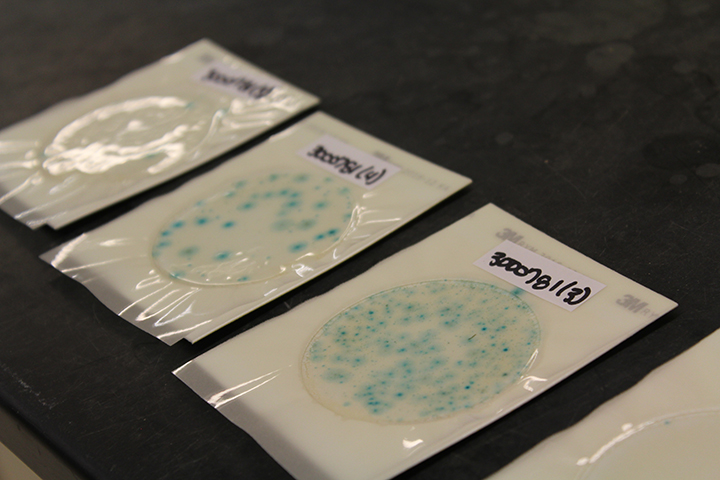 Anti-Nutritional Measures
Anti-Nutritional Measures
Manage the risks posed by bacteria, mold, yeast, and mycotoxins through count, identification, and screening options
Bacteria, mold, yeast, and mycotoxins are in a class all of their own, and by wreaking havoc on animal feeds, they've earned the category name of "anti-nutritional factors". Managing the risks associated with these organisms is possible through counts, identification, and screening as soon as there are suspected anti-nutritional factors at play. Rock River Laboratory offers basic and advanced analysis for bacteria, mold, yeast, and mycotoxins, while also partnering with other laboratories for more involved needs. Analyses offered, along with guidelines for resulting count levels can be reviewed below.
Bacteria, Mold, Yeast, and Mycotoxin Analyses
- Forage and TMR Hygiene Diagnostic Package
- Yeast and mold count: Requires a 5-day incubation
- Yeast and mold count and identification
- Rapid mold and yeast count: For those needing counts quickly, this analysis provides mold and yeast levels after a 2-day incubation, but does not offer identification.
- Clostridium perfringens count
- Total enterobacteria count: Measures bacteria count of all species included in the Enterobacteriaceae family
- Mycotoxin analysis: DON, Zearalenone, T-2, Fumonisin, or Aflatoxin
Guidelines for Resulting Levels of Mold, Yeast, and Toxins
Fungal and Bacterial Count Guidelines for Agricultural Feed and Total Mixed Rations
Mycotoxin Guidelines and Dietary Limits
Mycotoxin Decisions
Without any notice, you could be dealing with mycotoxins infiltrating the available ration components. If you suspect mycotoxins contamination of feed resources, what steps should you take to confirm? The expert team at Rock River Laboratory recommends:
1) Following a simple decision tree to make an assessment of the mycotoxin load
2) Ascertain the root of the challenges
3) Put mitigation steps in place
Download the mycotoxin decision tree here to see the steps based on what you're suspecting.
Mycotoxin Analyses
Mycotoxins can lie unrecognized in feed and may prove detrimental to an animal’s performance. Analyzing feedstuffs is the first step to mitigating these animal health and production threats. Rock River Laboratory’s mycotoxin analysis takes testing to the next level to help shed light on the root of on-farm ration challenges by offering:
Timely results
Mycotoxin screens can be completed in as little as three to four days* – helping diagnose feedstuff challenges quickly. The faster the analysis results, the quicker a mitigation strategy can be put into action to stop production losses and improve animal health.
Accurate analysis
Rock River Laboratory employs a mass spectrometry technique, the gold standard in animal nutrition and biochemistry, to analyze samples for mycotoxin concentrations. Mass spectrometry offers unmatched accuracy and precision, with better detection limits than other techniques.
Deciphering mycotoxin level reports shouldn’t require a PhD degree. Rock River Laboratory has crafted a visual, interpretive report to easily showcase where mycotoxin levels lie on the spectrum of ‘below detection limit’, to ‘concern’ level, to ‘near-maximum concentrations ever recorded’ for a total diet - allowing for quick and sound decisions. Explore our example visual mycotoxin report here.
Rock River Laboratory’s team has the mycotoxin expertise and supporting resources available to assist when such challenges arise. Contact Rock River Laboratory to learn more, and download our information sheet here.
Mycotoxin Analysis Packages
When it comes to analyzing feed and feed products for anti-nutritional substances beyond yeast and mold, Rock River Laboratory offers a variety of mycotoxin analysis packages. There is a boundless amount of information regarding which toxins, at what levels, cause certain ailments. The focus here is to help you decide which package is right for you based on your identifying needs.
Basic Mycotoxin Screen [Most Popular Mycotoxin Package]
|
Analyte |
Method |
|
Aflatoxin |
LCMSMS |
|
Deoxynivalenol |
LCMSMS |
|
T-2 Toxin |
LCMSMS |
|
Zearalenone |
LCMSMS |
Comprehensive Mycotoxin Screen
|
Analyte |
Method |
|
Aflatoxin |
LCMSMS |
|
Deoxynivalenol |
LCMSMS |
|
Fumonisin |
LCMSMS |
|
Ochratoxin A |
LCMSMS |
|
T-2 Toxin |
LCMSMS |
|
Zearalenone |
LCMSMS |
